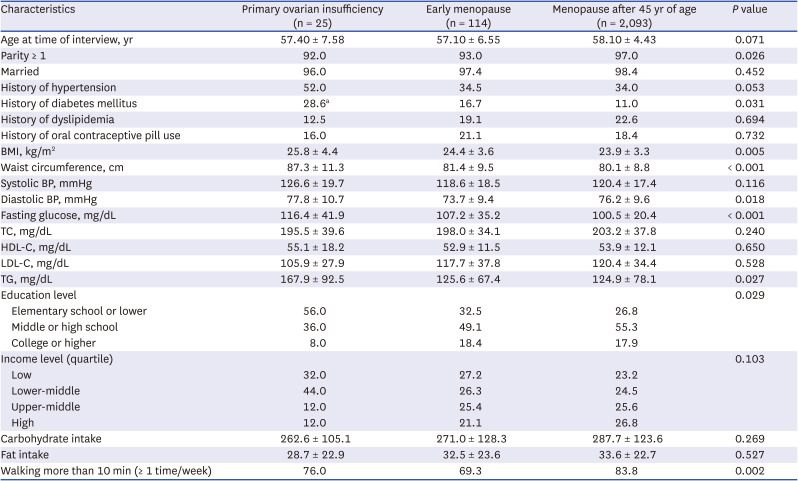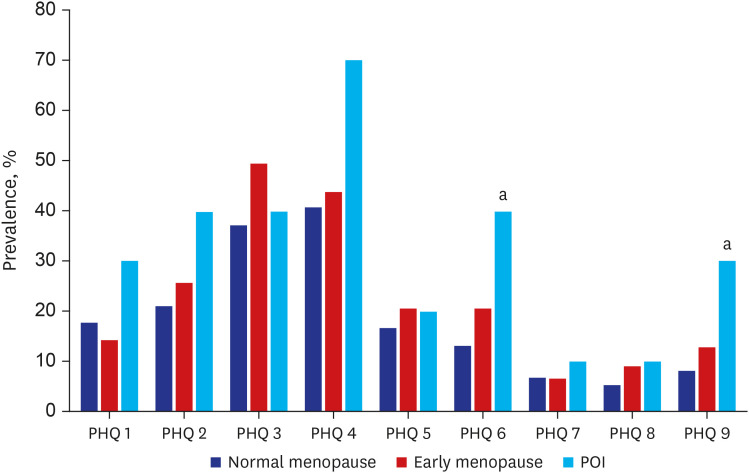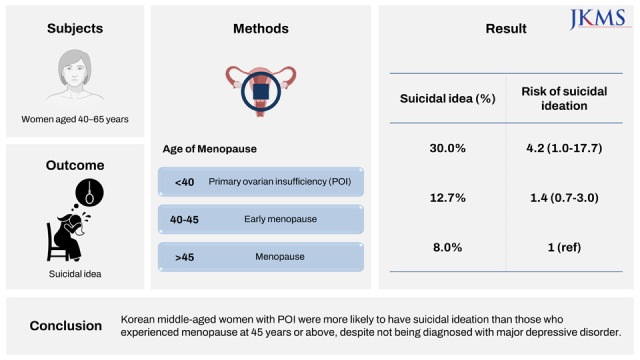1. Xu X, Jones M, Mishra GD. Age at natural menopause and development of chronic conditions and multimorbidity: results from an Australian prospective cohort. Hum Reprod. 2020; 35(1):203–211. PMID:
31955198.
2. Santoro N. Mechanisms of premature ovarian failure. Ann Endocrinol (Paris). 2003; 64(2):87–92. PMID:
12773939.
3. Kokcu A. Premature ovarian failure from current perspective. Gynecol Endocrinol. 2010; 26(8):555–562. PMID:
20500113.
4. Lim YM, Jeong K, Lee SR, Chung HW, Lee W. Association between premature ovarian insufficiency, early menopause, socioeconomic status in a nationally representative sample from Korea. Maturitas. 2019; 121:22–27. PMID:
30704561.
5. Choe SA, Sung J. Trends of premature and early menopause: a comparative study of the US National Health and Nutrition Examination Survey and the Korea National Health and Nutrition Examination Survey. J Korean Med Sci. 2020; 35(14):e97. PMID:
32281314.
6. Uygur D, Sengül O, Bayar D, Erdinç S, Batioğlu S, Mollamahmutoglu L. Bone loss in young women with premature ovarian failure. Arch Gynecol Obstet. 2005; 273(1):17–19. PMID:
16007508.
7. Roeters van Lennep JE, Heida KY, Bots ML, Hoek A. collaborators of the Dutch Multidisciplinary Guideline Development Group on Cardiovascular Risk Management after Reproductive Disorders. Cardiovascular disease risk in women with premature ovarian insufficiency: a systematic review and meta-analysis. Eur J Prev Cardiol. 2016; 23(2):178–186. PMID:
25331207.
8. Deeks AA, Gibson-Helm M, Teede H, Vincent A. Premature menopause: a comprehensive understanding of psychosocial aspects. Climacteric. 2011; 14(5):565–572. PMID:
21854296.
9. Georgakis MK, Thomopoulos TP, Diamantaras AA, Kalogirou EI, Skalkidou A, Daskalopoulou SS, et al. Association of age at menopause and duration of reproductive period with depression after menopause: a systematic review and meta-analysis. JAMA Psychiatry. 2016; 73(2):139–149. PMID:
26747373.
10. Bromet E, Andrade LH, Hwang I, Sampson NA, Alonso J, de Girolamo G, et al. Cross-national epidemiology of DSM-IV major depressive episode. BMC Med. 2011; 9(1):90. PMID:
21791035.
11. Vos T, Flaxman AD, Naghavi M, Lozano R, Michaud C, Ezzati M, et al. Years lived with disability (YLDs) for 1160 sequelae of 289 diseases and injuries 1990-2010: a systematic analysis for the Global Burden of Disease Study 2010. Lancet. 2012; 380(9859):2163–2196. PMID:
23245607.
12. Cuadros JL, Fernández-Alonso AM, Cuadros-Celorrio AM, Fernández-Luzón N, Guadix-Peinado MJ, del Cid-Martín N, et al. Perceived stress, insomnia and related factors in women around the menopause. Maturitas. 2012; 72(4):367–372. PMID:
22721806.
13. Pérez-López FR, Chedraui P, Gilbert JJ, Pérez-Roncero G. Cardiovascular risk in menopausal women and prevalent related co-morbid conditions: facing the post-Women’s Health Initiative era. Fertil Steril. 2009; 92(4):1171–1186. PMID:
19700149.
14. Nock MK, Hwang I, Sampson NA, Kessler RC. Mental disorders, comorbidity and suicidal behavior: results from the National Comorbidity Survey Replication. Mol Psychiatry. 2010; 15(8):868–876. PMID:
19337207.
15. Kweon S, Kim Y, Jang MJ, Kim Y, Kim K, Choi S, et al. Data resource profile: the Korea National Health and Nutrition Examination Survey (KNHANES). Int J Epidemiol. 2014; 43(1):69–77. PMID:
24585853.
16. Han C, Jo SA, Kwak JH, Pae CU, Steffens D, Jo I, et al. Validation of the Patient Health Questionnaire-9 Korean version in the elderly population: the Ansan Geriatric study. Compr Psychiatry. 2008; 49(2):218–223. PMID:
18243897.
17. Gilbody S, Richards D, Brealey S, Hewitt C. Screening for depression in medical settings with the Patient Health Questionnaire (PHQ): a diagnostic meta-analysis. J Gen Intern Med. 2007; 22(11):1596–1602. PMID:
17874169.
18. Cannon DS, Tiffany ST, Coon H, Scholand MB, McMahon WM, Leppert MF. The PHQ-9 as a brief assessment of lifetime major depression. Psychol Assess. 2007; 19(2):247–251. PMID:
17563207.
19. Koo KM, Kim K. Effects of physical activity on the stress and suicidal ideation in Korean adult women with depressive disorder. Int J Environ Res Public Health. 2020; 17(10):3502. PMID:
32429561.
20. Kim J, Kim JH. A facilitator of leisure activities for stress-related growth experience among middle-aged Korean women with depression. Health Care Women Int. 2014; 35(11-12):1245–1266. PMID:
25372946.
21. Rocca WA, Grossardt BR, Geda YE, Gostout BS, Bower JH, Maraganore DM, et al. Long-term risk of depressive and anxiety symptoms after early bilateral oophorectomy. Menopause. 2008; 15(6):1050–1059. PMID:
18724263.
22. Saunders KE, Hawton K. Suicidal behaviour and the menstrual cycle. Psychol Med. 2006; 36(7):901–912. PMID:
16573848.
23. Arevalo MA, Azcoitia I, Garcia-Segura LM. The neuroprotective actions of oestradiol and oestrogen receptors. Nat Rev Neurosci. 2015; 16(1):17–29. PMID:
25423896.
24. Baca-Garcia E, Vaquero C, Diaz-Sastre C, Ceverino A, Saiz-Ruiz J, Fernández-Piquera J, et al. A pilot study on a gene-hormone interaction in female suicide attempts. Eur Arch Psychiatry Clin Neurosci. 2003; 253(6):281–285. PMID:
14714116.
25. Wie JH, Nam SK, Ko HS, Shin JC, Park IY, Lee Y. The association between abortion experience and postmenopausal suicidal ideation and mental health: results from the 5th Korean National Health and Nutrition Examination Survey (KNHANES V). Taiwan J Obstet Gynecol. 2019; 58(1):153–158. PMID:
30638471.
26. Chang JC, Yen AM, Lee CS, Chen SL, Chiu SY, Fann JC, et al. Metabolic syndrome and the risk of suicide: a community-based integrated screening samples cohort study. Psychosom Med. 2013; 75(9):807–814. PMID:
24163389.
27. Simon GE, Rutter CM, Peterson D, Oliver M, Whiteside U, Operskalski B, et al. Does response on the PHQ-9 depression questionnaire predict subsequent suicide attempt or suicide death? Psychiatr Serv. 2013; 64(12):1195–1202. PMID:
24036589.
28. Park SC, Sakong J, Koo BH, Kim JM, Jun TY, Lee MS, et al. Clinical significance of the number of depressive symptoms in major depressive disorder: results from the CRESCEND study. J Korean Med Sci. 2016; 31(4):617–622. PMID:
27051248.








 PDF
PDF Citation
Citation Print
Print




 XML Download
XML Download